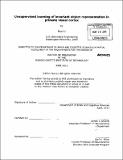| dc.contributor.advisor | James J. DiCarlo. | en_US |
| dc.contributor.author | Li, Nuo, Ph.D. Massachusetts Institute of Technology | en_US |
| dc.contributor.other | Massachusetts Institute of Technology. Dept. of Brain and Cognitive Sciences. | en_US |
| dc.date.accessioned | 2011-08-18T19:13:53Z | |
| dc.date.available | 2011-08-18T19:13:53Z | |
| dc.date.copyright | 2011 | en_US |
| dc.date.issued | 2011 | en_US |
| dc.identifier.uri | http://hdl.handle.net/1721.1/65288 | |
| dc.description | Thesis (Ph. D.)--Massachusetts Institute of Technology, Dept. of Brain and Cognitive Sciences, 2011. | en_US |
| dc.description | Cataloged from PDF version of thesis. | en_US |
| dc.description | Includes bibliographical references. | en_US |
| dc.description.abstract | Visual object recognition (categorization and identification) is one of the most fundamental cognitive functions for our survival. Our visual system has the remarkable ability to convey to us visual object and category information in a manner that is largely tolerant ("invariant") to the exact position, size, pose of the object, illumination, and clutter. The ventral visual stream in non-human primate has solved this problem. At the highest stage of the visual hierarchy, the inferior temporal cortex (IT), neurons have selectivity for objects and maintain that selectivity across variations in the images. A reasonably sized population of these tolerant neurons can support object recognition. However, we do not yet understand how IT neurons construct this neuronal tolerance. The aim of this thesis is to tackle this question and to examine the hypothesis that the ventral visual stream may leverage experience to build its neuronal tolerance. One potentially powerful idea is that time can act as an implicit teacher, in that each object's identity tends to remain temporally stable, thus different retinal images of the same object are temporally contiguous. In theory, the ventral stream could take advantage of this natural tendency and learn to associate together the neuronal representations of temporally contiguous retinal images to yield tolerant object selectivity in IT cortex. In this thesis, I report neuronal support for this hypothesis in IT of non-human primates. First, targeted alteration of temporally contiguous experience with object images at different retinal positions rapidly reshaped IT neurons' position tolerance. Second, similar temporal contiguity manipulation of experience with object images at different sizes similarly reshaped IT size tolerance. These instances of experience-induced effect were similar in magnitude, grew gradually stronger with increasing visual experience, and the size of the effect was large. Taken together, these studies show that unsupervised, temporally contiguous experience can reshape and build at least two types of IT tolerance, and that they can do so under a wide range of spatiotemporal regimes encountered during natural visual exploration. These results suggest that the ventral visual stream uses temporal contiguity visual experience with a general unsupervised tolerance learning (UTL) mechanism to build its invariant object representation. | en_US |
| dc.description.statementofresponsibility | by Nuo Li. | en_US |
| dc.format.extent | 176 p. | en_US |
| dc.language.iso | eng | en_US |
| dc.publisher | Massachusetts Institute of Technology | en_US |
| dc.rights | M.I.T. theses are protected by
copyright. They may be viewed from this source for any purpose, but
reproduction or distribution in any format is prohibited without written
permission. See provided URL for inquiries about permission. | en_US |
| dc.rights.uri | http://dspace.mit.edu/handle/1721.1/7582 | en_US |
| dc.subject | Brain and Cognitive Sciences. | en_US |
| dc.title | Unsupervised learning of invariant object representation in primate visual cortex | en_US |
| dc.type | Thesis | en_US |
| dc.description.degree | Ph.D. | en_US |
| dc.contributor.department | Massachusetts Institute of Technology. Department of Brain and Cognitive Sciences | |
| dc.identifier.oclc | 744966577 | en_US |
